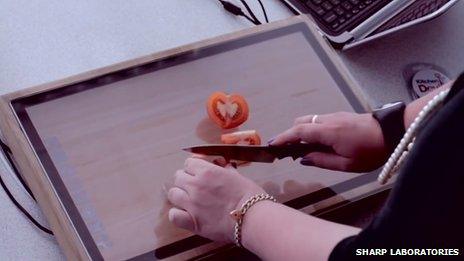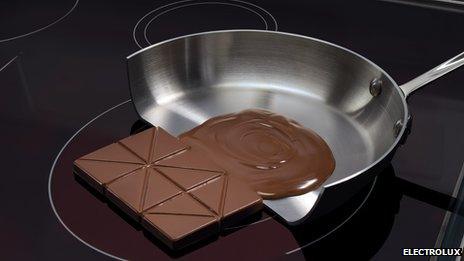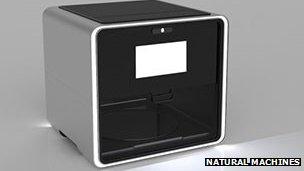Food bytes: The kitchen goes digital
- Published
Click's Melissa Hogenboom finds out more about a prototype that allows you to print your own food.
The kitchen of the future will be your interactive friend, helping you cook, shop and eat with optimum hygiene and efficiency.
And many of the technologies that will help us live this way are already here.
Smart fridges featuring wi-fi enabled tablet-style screens and barcode scanning technology can keep tabs on the foods they contain, including their use-by dates.
They can even suggest recipes based on what you have in stock and send all this information to your smartphone.
Most of our kitchen appliances are getting brainier, from the humble chopping block to the multifunction oven.
And as the "internet of things" gathers pace, it might not be too long before all our gadgets are talking wirelessly to each other as well.

The Chop-syc prototype is an interactive multifunction touch screen chopping board
Chop-syc is a multifunction interactive touchscreen chopping board created by product designer Siobhan Andrews.
Her prototype recently won the #GetItDownOnPaper competition for inventors. funded by Sharp Laboratories of Europe and Humans Invent.
It is a wi-fi enabled board that can weigh ingredients, suggest recipes and scale the quantities up or down according to the number of diners.
Ms Andrews said she wanted the board to "simplify healthy cooking".
Chop-syc can also add recipe ingredients to your online shopping list and place a supermarket order for you.
Toughened glass, coupled with the ability to reduce touchscreen sensitivity, means you can chop away to your heart's content without fear of damage.
"The health dimension was something that really attracted us," said Ian Thompson, managing director of Sharp Laboratories of Europe.

Nutrima, a wi-fi enabled bendy mat capable of measuring the weight and nutritional value of foods, was a finalist in the 2013 Electrolux Design Lab competition
Janne Palovuori, from Finland, was a finalist in the 2013 Electrolux Design Lab competition with her Nutrima food analysis mat prototype.
It can be charged by bending and then measures the weight, toxicity and nutritional value of ingredients placed on it, as well as helping you source local foods online.
As bendy screen technology develops, we will soon be able to slap this kind of interactive intelligent mat on any vertical or horizontal surface.
And it does not take a great leap of imagination to see how these intelligent gadgets will soon be sharing information with our intelligent fridges.
Fabrice Boutain's HAPIfork, launched this year, monitors how fast we eat in an attempt to get us to slow down. Eating too fast has been shown to contribute to obesity, because our sense of hunger and satiety lags behind the scoffing process.
Our eating habit data can be uploaded to a computer and displayed graphically.

The HAPIfork monitors how fast you eat and uploads the data to your computer and smartphone
'Precise temperatures'
Henrik Otto, Electrolux's vice-president of design, told the BBC: "There is still a lot of technology that hasn't become the everyday property of consumers, such as induction cooking."
It uses alternating electric current to produce an oscillating magnetic field that then heats up a ferromagnetic pan. It is a faster, more energy-efficient way to heat food than the traditional gas burner or electrically heated coil hobs.
"This allows for very precise temperatures," says Mr Otto.
The latest induction hobs include automatic pan recognition, which means the zone will only heat up once it has recognised that a typical saucepan shape has been placed on it.
This prevents smaller metal objects, such as spoons or bottle openers, getting hot if they are left on the induction zones.
But Mr Otto believes the technology could be applied more extensively.

Induction only heats the pan, not the surface
"What if your entire counter top or table incorporated induction technology?" he asks. "What if it could be used to power your other appliances?"
As populations grow and compact urban living becomes the norm, "rooms will have to morph throughout the day and our technology will have to multitask", he says.
"For example, a living room coffee table could also be an induction cooktop that then charges your laptop overnight."
Squidgy food
While we may still be a long way from Star Trek-style food replicators, lazy cooks and time-poor parents might take heart from a new invention from Barcelona start-up Natural Machines.
Richard Taylor weighs up the pros and cons of 'smart' scales
It has developed Foodini, a prototype 3D printer that can produce a range of foodstuffs, from chocolate to ravioli, from a number of ingredients, as long as they are squidgy.
Technically, this is piping, not printing, and the results are unlikely to win any prizes on MasterChef.
But the machine can combine up to six different ingredients from separate nozzles to create a potentially wide range of foods in precisely programmed shapes.
Nasa has been looking at similar technology to help provide more exciting mealtimes for astronauts on the International Space Station.

Natural Machines hopes its Foodini food printer will end up looking like this
Lynette Kucsma, the company's chief marketing officer, told the BBC: "We're looking for everyday foods you would eat, so savoury foods from ravioli to gnocchi... to decorating toast that you might have for breakfast."
Its makers envisage networked machines sharing culinary creations across social media, and workers being able to set them up in advance so that your food is ready for you when you arrive back home.
Chief executive Emilio Sepulveda thinks the Foodini will probably cost about 1,000 euros ($1,350; £833), although we are unlikely to see it in stores soon.
But as the networked digital kitchen comes closer, many of us are still waiting for the perfect gadget: an espresso maker equipped with voice biometrics.
Just one word and it will brew up the perfect, personalised coffee. Now that would be progress.
- Published21 September 2013
- Published16 July 2013
- Published24 October 2011